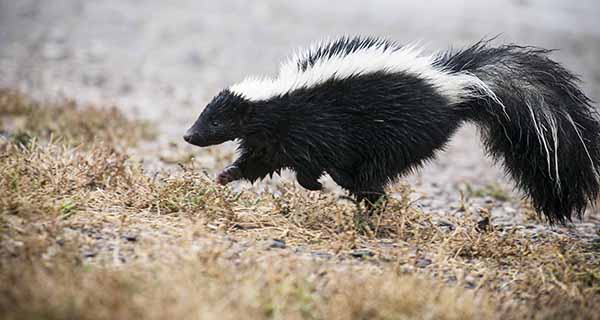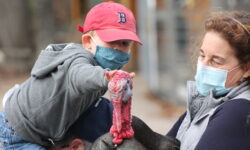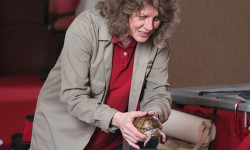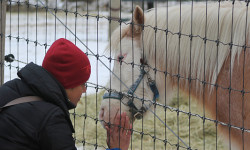[ccfic caption-text format="plaintext"]
By Lisa Moore
Hometown Weekly Correspondent
As winter reluctantly releases its grip over the region and hibernators and migrators reappear in the area, familiar sights and sounds return, declaring that winter is over and spring has officially begun. Birds, squirrels, rabbits and chipmunks have returned to view, moving about in our neighborhoods. Soon, the greening of the landscape will restore color to the gray and washed-out winter world. As the plants bud, overwintering insect eggs and larva will hatch or emerge, taking advantage of the fresh greenery for food and shelter. With spring comes the renewal of life, and the quiet winter nights will soon be abuzz with a chorus of songs from those animals big and small that roam the land at night.
As the sun sets and evening descends, it is a signal for some creatures to seek shelter and prepare to sleep, end their day’s work, take time to rest and recover, and hide from predators until the dawn breaks.
For others, however, dusk stirs their slumber like an alarm clock blaring the call to rise. Night is the time when nocturnal animal go about the tasks of their daily lives; under the cover of darkness, a busy community of critters large and small scurry, creep and fly through our neighborhoods and yards - all while most of us are fast asleep.
For some animals, the cover of darkness hides their presence from the many predators that would like to eat them, giving them a better chance at survival. For other animals, the night is when their prey is most active - thus, they must hunt at night when food is most readily available. Predator and prey have evolved to be best suited for an active life in the dark.
Many people associate nocturnal animals with two flying examples: the owl and the bat. The owls that most often visit our neighborhoods are the great horned owl, the barred owl and the eastern screech owl. These birds are designed for stealth. Nearly silent in flight, the owls are equipped with excellent vision, hearing, scalpel like talons, and beaks designed for tearing. These predators often use the cover of darkness to hunt their prey.
Moles, voles, mice, frogs, snakes, birds, bats, insects, and rabbits are on the menu for owls. Lacking teeth, the birds swallow whole or tear into pieces their quarry, digesting the soft parts and regurgitating the non-digestible bones, feathers, hair, and fur as a pellet. These pellets can often be found at the base of tall trees, where the owls safely feed on their prey at night. When dissected, the pellets can reveal insight into what the owl has eaten by observing the fur, feathers, hair, and tiny skeletons left from the remains of prey eaten.
Bats are also nocturnal flyers, and the little brown bat is the most common species in the northern Unites States. Theses mammals are a most misunderstood animal. Feared by many people, bats’ biggest predators are people - through pesticides, traps, habitat destruction, and the accidental spreading of deadly white nose fungus spores, humans are destroying bat colonies. While occasionally eaten by raccoons, owls, or house cats, these animals play a vital role in the natural food web.
Over 5.5 million bats have died in the last several years as a result of white nose syndrome, which is caused by a fungus. The fungus can be spread by people who visit recreational areas where bats roost, like caves. When humans travel from one cave to another, they can carry fungus spores on their shoes and clothes, exposing new colonies to the deadly disease. Over 5 million bats have been killed by white nose syndrome since researchers have become aware of it; those bats would have consumed over 3500 tons of insects, most of which are agricultural pests.
Fewer bats mean more mosquitos, aphids, and crop failures. A study published in the journal Science stated bats provided nearly 4 billion dollars in pest control services to US agriculture each year. Bats come out at night to feed on the many insect prey that emerge. They use echolocation to locate their prey, feeding in flight or catching prey as it lands on plants or surrounding objects. Little brown bats love to catch mosquitos, and mosquitos like to bite humans.
Mosquitos carry more diseases and pose a greater health risk to humans than bats, as they carry diseases such as malaria, yellow fever, eastern equine encephalitis, West Nile virus and zika virus, to name only half. To say the least, with all the benefits bats provide humans, they should be revered, not feared.
Another dusk visitor to our yards is the white-tailed deer. Although they are the smallest members of the North American deer family, they are one of the largest animals that roam the area, growing up to seven and a half feet tall and weighing 300 pounds. These herbivores spend their waking hours grazing on most available plant foods. Their diet includes leaves, twigs, fruits, nuts, grasses, corn, alfalfa, and even lichens and other fungi. These animals are wary and nervously keep their eyes out for predators. At the first sign of danger, they will lift their tails, exposing the bright white underside - a signal to other deer that a predator is near. The best defense a deer has from predators is its speed. They are capable of jumping 10 feet high and a distance of thirty feet in a single bound. They can reach sprinting speeds of 30 MPH.
The top predator in this region is the coyote. This animal is one of the most adaptable animals, able to survive in almost any environment, from urban sprawl to dense forest. They are incredibly intelligent, and will eat almost anything, from insects and fruit to frogs, grass, fish, snakes, deer, dead animals, garbage leftovers, and even unattended pets and livestock. This animal is another that is often misunderstood. Coyotes play a vital role in the food web, keeping in check populations of animals like rabbits, mice, deer, and squirrels. They den in spring, giving birth to litters of 3-12 pups. Both parents care for the young, forming strong family bonds. By fall, the pups will be able to hunt for themselves, eventually moving on to find mates of their own.
One of the least respected animals that roams the region at night is the skunk. This quiet and reclusive animal ambles through neighborhoods at night in search of food. A relative of the stink badger, this animal will often leave tall tail markings of its nightly visit. Skunks are omnivores, eating insects, larvae, rodents, amphibians, eggs, roots, berries, and leaves. As the animal searches for earthworms and grubs or other insect larva in the grass, it leaves swirl-like holes called chevrons. Skunks have poor vision, but their excellent sense of smell helps them to find their food. Their defense mechanism to avoid predation is to spray a noxious liquid from an anal gland. The liquid contains sulfur compounds, which give it a powerful aroma, useful to ward off potential predators.
As the snow finally melts and the greening season of spring brings life back to the region, be on the lookout for all of the amazing critters that live among us as they go about their lives, all playing out the important roles they have in the web of life. To avoid unintentional contact with these animals, keep pet foods stored inside, remove trash and store it inaccessible containers, and keep pets and livestock secured at night.






















